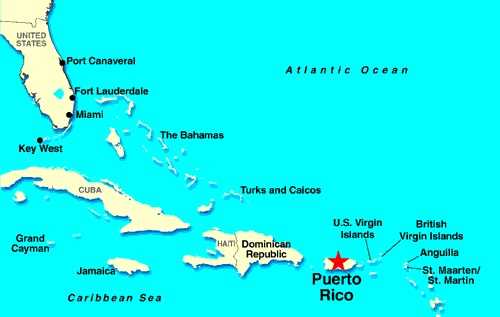SAN JUAN, Puerto Rico – The dream of reviving Puerto Rico’s chocolate tradition took root in Juan Carlos Vizcarrondo’s mind years ago.
He’s always been obsessed with flowers and trees. As a boy, he planted so much greenery in his mother’s backyard, there was hardly room to walk.
But in his thirties, he started planting cocoa trees, with their colorful pods full of magical seeds. “Something told me, just keep planting, because nobody has it! It’s so strange, nobody has it!,” he recalls.
Centuries ago, there were whole plantations of cocoa trees here in Puerto Rico. The climate is perfect for them.
But a series of hurricanes wiped out much of the island’s agriculture in the early 1700s, and cocoa farming never recovered.
Most cocoa now is harvested in places where labor is cheaper, like in West Africa.
But you can still find cocoa trees growing wild in the Puerto Rico’s hills, with yellow and purple pods, shaped like miniature footballs, sprouting from trunks and branches. Vizcarrondo went looking for them, and found a few.
“Once I had the pods in my hands, I was so impressed,” he says, and the wonder is still audible in his voice.
“I started opening them and sucking on the pulp, and that was delicious. I started drying them out in the sun.”
He tried grinding up the beans to make his own chocolate. The result tasted terrible at first. Nevertheless, he persisted. Over the course of a decade, he learned how to ferment the beans, how to grind them, and temper the resulting chocolate.
“Finally, people told me, ‘Ok, I like it now! I’m starting to like it!’ That’s where I said, ok, this is interesting,” Vizcarrondo says.
Eight years ago, he set up a little company called Loiza Dark, making chocolate just from beans that he grows on his own farms.
His “factory” is just three small rooms alongside a highway near the San Juan airport. He sells to local restaurants, specialty shops, and takes some orders through his web site.
Lately, though, the idea of home-grown Puerto Rican chocolate has found an influential new supporter: Eduardo Cortes, who runs a family business called Cortes Hermanos, which just happens to be the biggest chocolate producer in the Caribbean.
His company’s factories and farmers are mostly in the Dominican Republic, but “I was raised in Puerto Rico; I’m Puerto Rican, and I always wanted an opportunity to do what I like to do best in Puerto Rico,” Cortes says.
Cortes sensed that opportunity one day in 2011, when he saw something odd: a truck full of cocoa pods on a Puerto Rican highway.
Cortes had never heard of anyone growing cocoa on that scale in Puerto Rico. “I stopped the truck and asked the driver where [the pods] were from,” he says. “And he said that they were from a research station in Mayaguez.”
The city of Mayaquez sits on Puerto Rico’s western coast. Cortes didn’t know it, but this is where the U.S. Department of Agriculture carries out much of its research on tropical crops.
Cortes got in touch with scientists at the research center and discovered that they had a huge collection of cocoa trees. Not only that – they’d just spent twenty years identifying nine new, highly productive varieties of the tree.
Cortes sensed an opportunity. He recruited a small group of farmers in Puerto Rico to grow these great new trees and make a high-end chocolate bar just from those beans.
“There’s always going to be a little market for people who want to eat local chocolate, just like there is for coffee,” Cortes says. “I know at least that is possible. And from there, maybe it becomes a little bit more [economically] competitive, who knows?” The new trees, he says, will yield three times as much cocoa as the average tree in today’s commercial cocoa farms. Perhaps that will make up for the extra cost of labor in Puerto Rico.
One of the farms where the new trees are growing sits in the hills near Mayaquez. It looks more like a forest than a farm. But scattered across the steep hillside, in the shade of big trees all around them, I see lines of young cocoa trees, over a thousand in all. They’re fragile-looking plants, just four or five feet tall. Most aren’t yet producing any pods.
Jose Martinez Cruzado, who owns this farm and agreed to work with Cortes on this project, tells me that when he was a boy, he’d see wild cocoa trees in the hills. “And I’d say, ‘Hey, I love chocolate, I’d like to grow cocoa one day in my life!'”
Cruzado doesn’t depend on farming for a living. He’s also a professor of engineering at the University of Puerto Rico at Mayaguez.
“I’m doing this for the enjoyment, but if I get some money, I’ll enjoy it a lot more!” he says, laughing.
Cortes has launched his new, premium line of chocolate, called Forteza. The bars come packaged in a distinctive metal box. Right now, most of them are still made from cocoa grown in the Dominican Republic, but as the Puerto Rican trees start producing pods, that should change.
Word of this new venture has spread. A couple of hundred other Puerto Rican farmers have called Cortes, out of the blue, asking how to get their hands on these new trees. All of them, it seems, want to help bring back chocolate-making on their own Caribbean island.
Dan Charles















